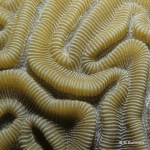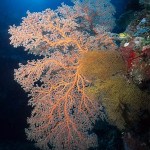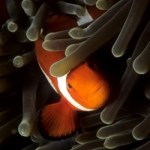Celebes Sea
Scleractinian corals, also known as stony corals -- or just hard corals -- are the primary reef builders in the oceans. Their polyps secrete calcium carbonate to form a skeleton. A minority of species live as single polyps, but most stony coral species are colonial, and the structures they build 'grow' over time. They form a myriad of shapes: mounds, branches, fingers, plates, and encrustations.
In several previous posts I discussed and displayed photos of a number of so-called soft corals, all of which are octocorals, i.e., their polyps have eight tentacles. Stony corals are…
Sea fans are among the most beautiful sights seen by divers. Gorgonian sea fans are Cnidarians that build colonies in branching formations that usually are fan-shaped, thus the common name.
Like the Nephtheid soft corals I wrote about recently here on Photo Synthesis, Gorgonians are octocorals: each polyp has eight pinnate tentacles which it uses to capture nutrients suspended in the water column. They are seen most often on reef crests, or jutting out from drop-offs or steep banks in locations where natural currents will sweep plankton and other organic nutrients across the polyps'…
Many animals in the ocean seek shelter from predators by living on or among other animals. Among fishes, members of the Damselfish family (Pomacentridae) often seek protection this way. Some of these relationships also are commensal or even symbiotic.
One of the most well known symbiotic relationships in the marine world is that between anemones and fishes commonly known as 'clownfish' or 'anemonefish'. Clownfish form a subfamily, Amphiprioninae, of the Dameselfish family. Each of the twenty-some species in this subfamily lives symbiotically with one or more anemone species.
Both the…
Crinoids, a class of marine animals in the phylum Echinodermata, are pretty creatures. The photo at right shows a crinoid perched on a Malaysian reef with its fluffy arms extended for feeding. Looking at the photo, it's easy to see how they acquired their common name, Feather Stars.
This is how divers usually see crinoids, and this is how they are most often photographed. As pretty as crinoids are -- and they come in a vast array of colors -- photographs of the whole animal don't reveal much about the animal's structure or behavior. Whole-animal photos of creatures like this should be…
The AP just reported that project leader Dr. Larry Madin of the Woods Hole Oceanographic Institution and Phillipine scientists returned from two weeks in the Celebes Sea, located off the Phillippines southernmost archipelago, this Tuesday with some potential new deep sea discoveries. Among the more interesting finds were a strange black jellyfish, a transparent sea cucumber and a spiny orange worm that had 10 squid-like tentacles. "I'll have to try a bite of each one with Old Bay before we determine whether they are truly new species or not" Dr. Madin joked. Adding, "you think I'm kidding,…



